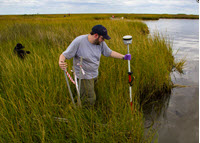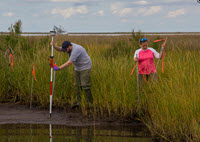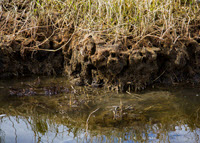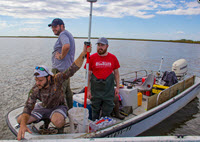
Shearing typically occurs along coastal marshes when strong storms rip away the plants at the marsh edge. Because oiled shoreline sediment is in a weakened state and less able to securely hold plants in place, some Louisiana marshes that were heavily oiled following Deepwater Horizon are experiencing more shearing than usual. The loss of vegetation adversely affects the entire marsh ecosystem.
Patrick Rayle uses metabarcoding methods to examine differences in meiofauna biodiversity in oiled and unoiled Louisiana marshes that have experienced shearing. His research can help us better understand how meiofauna communities respond to these co-occurring stressors. He also wants to help answer questions about whether losing the marsh edges through erosion will diminish the diversity of this unique intertidal ecosystem.
Patrick is a master’s student with the Louisiana State University AgCenter’s Department of Entomology and a GoMRI Scholar with the project A Study of Horse Fly (Tabanidae) Populations and Their Food Web Dynamics as Indicators of the Effects of Environmental Stress on Coastal Marsh Health.
His Path

Patrick’s father is a biologist for a Louisiana environmental consulting firm, which made biology a common dinner table topic that Patrick really enjoyed growing up. Later, while completing a marine-focused biological sciences undergraduate degree at Louisiana State University, Patrick worked with Dr. Ken Brown, a Coastal Waters Consortium team member investigating how Deepwater Horizon oiling affected marsh microbial communities. Afterwards, he eagerly accepted a graduate research position with Dr. Lane Foil and Dr. Claudia Husseneder, who were also investigating Deepwater Horizon impacts on Louisiana marshes.
“I’ve lived my entire life just outside of New Orleans, and the various disasters that the community experienced over the years had a large impact on my life,” said Patrick. “When the oil spill hit, it was extremely frustrating that, as a teenager, there really wasn’t much I could do about it. Working on this research examining long-term effects of the spill has been cathartic for me – it feels like I can make a difference in the response the next time something like this happens.”
His Work

Patrick collects soil samples from six Barataria Bay marsh sites using a Barrett soil coring device equipped with replaceable acrylic cores for extracting large, consistently-sized soil samples with minimal cross-contamination risks. He collects five samples at each site from increasing elevations that are .05m apart. Then, he extracts DNA from the samples and uses polymerase chain reaction (PCR) to amplify the short eukaryotic 18S region of the DNA and capture DNA sequences for the microscopic meiofauna living in the soil.
Patrick applies Illumina Hi-seq DNA sequencing techniques to the amplified region to reveal the exact sequence of each organism in the sample. Using bioinformatics algorithms, he matches the regions with previously identified and sequenced species available in a public DNA database. This process generates a table of all the species matched to the collected organisms, which Patrick uses to examine biodiversity differences between healthy and sheared sites that experienced oiling.

Patrick’s early results show that sheared sites exhibited lower biodiversity than intact sites, which he hypothesizes may have been caused by plant loss associated with oiling. He is conducting a similar study examining biodiversity differences between sites that experience different salinity conditions. “I want to focus on salinity as well, because of the proposed mid-Barataria Bay freshwater diversions,” he explained. “These diversions are intended to help rebuild Louisiana marshes by reconnecting them to the Mississippi River’s sediment input. However, they will have a wide variety of effects on the marshes simply by changing the salinity regime. I want to determine what changes in meiofauna biodiversity are likely to happen in marsh areas with changing salinity.”
His Learning
Patrick is grateful to Drs. Foil and Husseneder for their mentorship, which improved important skills for his future scientific career. He recalls that Dr. Foil hosted a writing course to hone his writing skills for academic journals and that Dr. Husseneder patiently shared her extensive genetics knowledge with him. They also encouraged Patrick to attend the Second Benthic Invertebrate Taxonomy, Metagenomics, and Bioinformatics (BITMaB-2) Workshop, which gave him a solid foundation to conduct analyses using specialized bioinformatics programs.
“To me, GoMRI is about learning from and mitigating a major environmental disaster,” said Patrick. “The Deepwater Horizon spill is too large of an issue to be solved by any one researcher, but collectively we can make new discoveries that can aid in the recovery and prevention of issues like this in the future.”
Patrick also realized that his early research experiences helped him as a graduate student. “There are numerous opportunities available to students at the undergraduate level, but you have to look for them,” he said. “Many citizen science programs can give you a better idea of what type of work is required to do research.”
Moving forward, Patrick wants to pursue an environmental science position in industry or government.
Praise for Patrick
Drs. Foil and Husseneder praised Patrick’s adaptability in difficult conditions, saying that he applied his Eagle Scout skills and values to many aspects of the research. “He confidently navigated the Gulf of Mexico estuary, trekked through muddy marshes in all weather conditions, fought through the jungle of bioinformatics, and showed great perseverance in his endeavors,” said Dr. Husseneder. “Patrick is on his way to becoming a well-rounded biologist, i.e., not afraid to tackle mucky field work, big data, and computer command lines.”
Dr. Husseneder said that Patrick’s work is an example of the collaborative nature of the GoMRI program since his research is integrally linked with his fellow graduate students’ projects. “Data from Patrick’s study dovetail with projects of former GoMRI scholars, including food web studies on horse flies (Devika Bhalerao), marsh insects (Ben Aker), and sea side sparrows (Allison Snider).”
The GoMRI community embraces bright and dedicated students like Patrick Rayle and their important contributions. The GoMRI Scholars Program recognizes graduate students whose work focuses on GoMRI-funded projects and builds community for the next generation of ocean science professionals.
By Stephanie Ellis and Nilde Maggie Dannreuther. Contact sellis@ngi.msstate.edu for questions or comments.
************
The Gulf of Mexico Research Initiative (GoMRI) is a 10-year independent research program established to study the effect, and the potential associated impact, of hydrocarbon releases on the environment and public health, as well as to develop improved spill mitigation, oil detection, characterization and remediation technologies. An independent and academic 20-member Research Board makes the funding and research direction decisions to ensure the intellectual quality, effectiveness and academic independence of the GoMRI research. All research data, findings and publications will be made publicly available. The program was established through a $500 million financial commitment from BP. For more information, visit https://gulfresearchinitiative.org/.
© Copyright 2010-2019 Gulf of Mexico Research Initiative (GoMRI) – All Rights Reserved. Redistribution is encouraged with acknowledgement to the Gulf of Mexico Research Initiative (GoMRI). Please credit images and/or videos as done in each article. Questions? Contact web-content editor Nilde “Maggie” Dannreuther, Northern Gulf Institute, Mississippi State University (maggied@ngi.msstate.edu).
